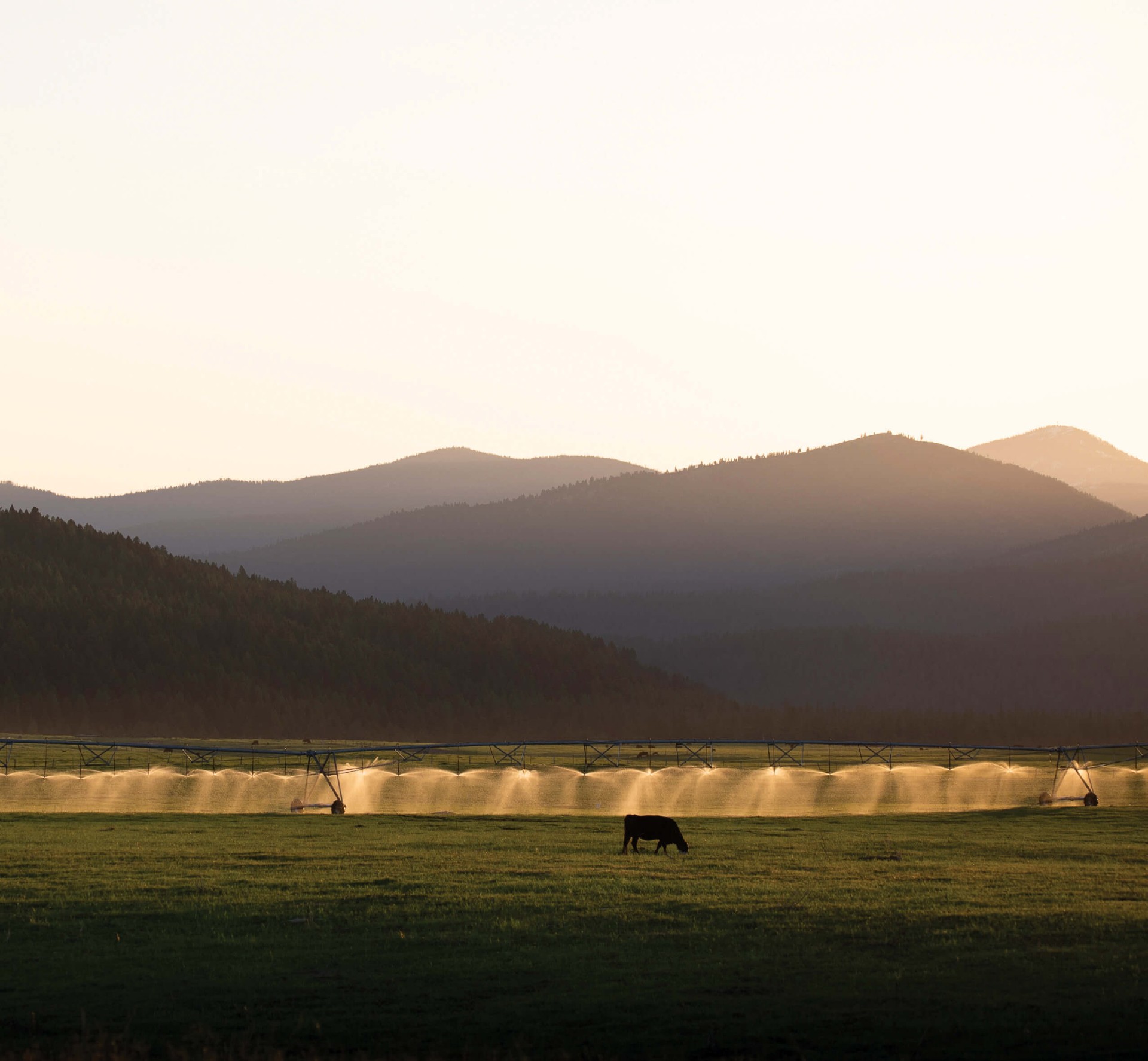
28 Sep Partnered Up
In the rural 1.5-million-acre Blackfoot watershed, Montana’s characteristic working lands are on full display. Generational ranches are replete with grazing cattle and haystacks; rolling grass and strings of timber are seldom interrupted by the intermittent farmhouse or cabin; deer and elk graze, while waterfowl and songbirds decorate the riverbanks and sky.
In the center of the watershed, just off state Highway 200, the tiny town of Ovando serves as a rest stop along the Great Divide Mountain Bike Route that runs 2,700 miles from Canada’s Banff National Park to the U.S./Mexico border in New Mexico.
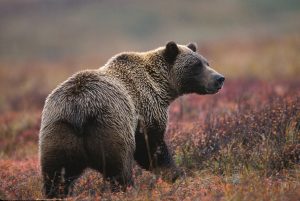
Donald M. Jones
In July 2021, Ovando made national headlines when a grizzly bear killed a California cyclist who was camping in town during her Great Divide tour. The bear, initially attracted to the campsite by food in the tent, killed 65-year-old Leah Davis Lokan before another couple in her party sprayed the bear with bear spray to drive it away. Three days later, after trapping efforts and helicopter searches were unsuccessful in locating the bear, wildlife officials shot and killed a six-year-old male grizzly after it raided a chicken coop just 2 miles outside of town. DNA tests confirmed it was the same bear that killed Lokan.
The incident was the first grizzly bear-caused death in the Blackfoot since 2001 and, according to conservation biologist Seth Wilson, Lokan’s death was a reminder that it takes continual work to live in areas that support bears. For over 20 years, Wilson has worked in the U.S., Canada, and Europe to resolve issues between people and wildlife. He currently serves as the executive director of the Blackfoot Challenge, a landowner-based organization that coordinates efforts to conserve and enhance the natural resources and rural way of life in the Blackfoot watershed.
For two decades, landowners and natural resource professionals have worked within the watershed to reduce human-bear conflicts, adopting innovative strategies like electric fencing and proactive livestock management, but Wilson contends the work is ongoing and needs to continue to evolve as changes occur on the landscape. These efforts are part of the Blackfoot Challenge’s long tradition of working with the people living in the watershed and are examples of how partnerships serve as a critical foundation for conservation solutions. By listening to, and learning from, each other, the watershed is making a collective effort to find strategies for safely living with grizzly bears that make the most sense for the community.
Guiding Light
It’s mid-afternoon in June and Jamie Jonkel has just sat down for a cup of coffee. Jonkel, a bear management specialist for Montana Fish, Wildlife & Parks (MT FWP) in Missoula, is responsible for responding to conflicts between grizzly bears and humans in the west-central part of the state. Hired by MT FWP in 1996, the Missoula native is following in the footsteps of his late father, a grizzly biologist who led research on the species after the bears were placed on the Endangered Species list in 1975. Jonkel has spent the last 25 years learning about bears, educating people, and dealing with issues when people and bears collide.
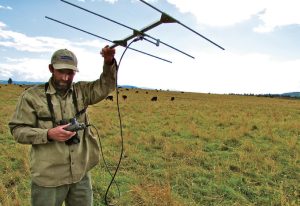
Blackfoot Challenge Wildlife Coordinator Eric Graham works closely with landowners and people living in the watershed to minimize conflicts with predators. He also assists Montana Fish, Wildlife & Parks with management actions such as tracking collared animals via telemetry or conducting research on bears (below). | Melissa Mylchreest
According to Jonkel, problems ramp up in the fall when bears seek more food in preparation for hibernation. As winter approaches, black bears and grizzlies often move into lower elevation foothills and valleys in search of berries and other vegetation, where they may become attracted to household items like garbage, fruit trees, dog food, or home gardens, sometimes even becoming bold and aggressive toward people.
Just a few short years into his position, a growing number of grizzly bears made an appearance in the Blackfoot Valley, where a coalition of landowners had recently incorporated as the Blackfoot Challenge in order to solve recreation issues on the Blackfoot River. “I saw how wonderfully the Blackfoot Challenge was functioning,” Jonkel says, so MT FWP asked the Blackfoot Challenge Board if there was a way to incorporate the management of grizzly bears into their watershed work.
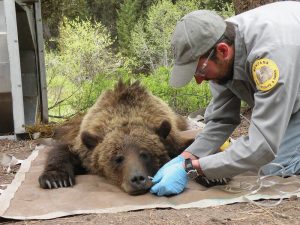
Barry Gordon
He admits there was some trepidation at first; predators were a sore subject for many ranchers that feared predation on their livestock and an end to their livelihood. “We had 11 grizzlies show up into a mountain valley that wasn’t prepared for grizzlies,” he says, adding that the bears quickly started to cause problems for ranchers. Historically, ranchers placed dead livestock in a boneyard near their calving pastures or barns, but, as bears returned to an area where they’d been absent for three decades, this type of carcass management began drawing bears close to homes. “These grizzlies started circling the valley, going from boneyard to boneyard,” Jonkel says. “We had upward of 11 at a time in a rancher’s backyard, where they found bird feeders, dog food, horse feed.”
In 2002, one year after a hunter was killed by a grizzly, the Blackfoot Challenge formed the Wildlife Committee to bring together landowners, biologists, and other interested parties to identify community values and recommend strategies for minimizing conflicts with bears. Since then, the committee has been instrumental in developing solutions that work for the Blackfoot communities. “The Wildlife Committee acts as a sounding board and provides guidance on issues,” says Jonkel, who is a member of the committee. “It serves as a guiding light.”
Making sausage
About a decade ago, Potomac, Montana rancher Denny Iverson bore witness to the scavenging nature of grizzlies. With his ranch tucked in the valley bottom, on the lower end of the Blackfoot watershed, he had transitioned from using a boneyard and was making use of the Blackfoot Challenge’s Carcass Pick-up Program. In the spring, when ranchers commonly lose a couple calves and birthing cows, personnel haul carcasses off the property for disposal. But, when Iverson lost a calf to pneumonia during the fall, he thought, rather than bother the program organizer out of season, he would just bury the dead calf in the old boneyard. “I threw 4 or 5 feet of dirt on top of it, then came by a few days later and it was dug up,” Iverson recalls. “I was amazed a bear would dig that far down to get to a critter.”
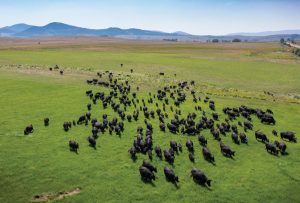
Jeremy Roberts, Conservation Media
Today, Iverson never dumps a carcass on the ranch. He says it’s just not worth it. “Even if a bear doesn’t dig it up, they still might be attracted [to the area] and get into some other type of trouble. A troublesome bear is a dead bear,” he says, referring to instances when managers euthanize a bear that has a history of causing conflict. “There are certain things that are our responsibility, like cleaning up our boneyards, or not keeping grain out.”
Iverson has been a member of the Blackfoot Challenge Board for nearly 20 years, and his ranch was among the first to participate in the Carcass Pick-up Program, through which carcasses are taken to a composting facility operated by the Montana Department of Transportation. Recently, a nearby ranch has begun utilizing the livestock compost to enhance soil health. In its first year, 63 carcasses were picked up from a handful of ranches. Today, approximately 90 percent of the valley’s livestock producers utilize the program and, in an average year, roughly 350 to 400 carcasses are removed and composted.
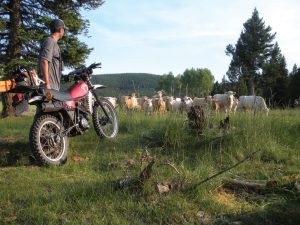
A range rider with the Blackfoot Challenge checks on cattle turned out on summer pasture. Through this program, seasonal staff monitor cattle in an effort to reduce wolf and grizzly predation. | Eric Graham
While the new carcass management tool was suggested by wildlife officials, Greg Neudecker of the U.S. Fish and Wildlife Service says landowners and ranchers ultimately decided how to organize the program and whether or not to try it. Neudecker, who is based in Ovando and was a founding member of the early Blackfoot Challenge Board, partners with private landowners in nine focus areas in Montana to develop conservation strategies for critical wildlife species. “Just because someone comes up with ideas, that doesn’t mean they’ll work on the ground for landowners,” he says. “One of the things you learn in community-based conservation is that the folks most affected need to be there during the sausage-making process.”
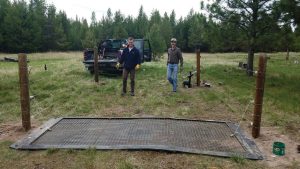
Recently, members of the Blackfoot Challenge have been working to develop an electrified drive-over mat that can be used in conjunction with electric fencing to keep bears from entering areas of human development. | Eric Graham
Neudecker says it was a sensitive issue to work through — ranchers don’t want to be judged by their peers about losing cattle, yet some loss is an inevitable part of animal husbandry. But, with dedication to what the Blackfoot Challenge calls the 80/20 rule, they were able to progress. On this premise, members commit to work on the 80 percent they have in common, not the 20 percent that divides. Once they have built trust and credibility on the 80 percent, then they’re able to tackle the remaining 20 percent. “You’ve got to focus on those things that you have in common,” Neudecker says. “The days of going at it alone, whether you’re a landowner, a conservation group, or an agency, are gone. It’s about partnering up, being a team, finding that common ground.”
Riding the Fences
Jim Stone stepped up to the helm of his family ranch at the ripe age of 24. He was fresh out of college and ready to take on the world. “I spent more time worrying about cows than wildlife,” says the Blackfoot Challenge Board Chair. Thirty years later, he says his mindset has changed. Rather than focus on his cattle, the rancher says he considers the environment and knows that, in turn, it will take care of his cattle. It’s what Stone calls a holistic approach, and includes wildlife-friendly fencing, intensive cattle management for soil health and weeds, and securing anything that might attract bears. “If you secure attractants on all the neighboring ranches, then the bears start to change their behavior. We have to neighbor up,” he says. “When you do it not only as a community, but as an entire watershed, that’s powerful. It gives those bears a chance and it gives us one, too. The bears are going to be able to be here and I think we will, too.”
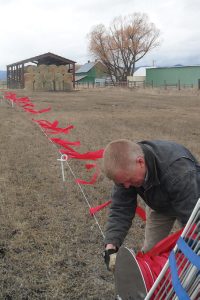
Cattle rancher Jim Stone installs fladry, an electric fence outfitted with red flags, to dissuade wolves from entering a calving pasture. | Seth Wilson
David Mannix, who is also a member of the Blackfoot Challenge Board, agrees with Stone. He and his family operate the Mannix Family Ranch, which dates back to 1882. “I was a lot more anxious 15 years ago than I am now, simply because I think I can see a way forward,” he says. “I think we’ll be able to maintain our livelihood. Ranching is a stewardship of the resource with a strong leaning for profit. We need to make a profit so we can be here for another generation, another decade, another year.”
Mannix says ranching and living around predators can incite fear and anxiety. He says mothers worry about their children playing in the yard and ranch hands are at risk of stumbling upon a bear while checking cattle or fixing fences. He describes having to euthanize a calf that was mauled by a bear or wolves: “You might feel like a failure in your husbandry of that calf. Emotionally, it is a big deal because the stress affects you every day, and just a few people shoulder the vast majority of that problem. We need ways to empathize with each other, rather than throw rocks at each other.”
For the Blackfoot watershed, an important catalyst for empathy has been education provided by the Blackfoot Challenge. Wildlife Coordinator Eric Graham has been with the organization since 2013, and says the wildlife program evolves based on the needs of landowners and ranchers. In addition to carcass pickup, he assists with electric fencing around backyard attractants like gardens, chicken coops, or beehives, as well as livestock areas, such as calving pastures. The Blackfoot Challenge also oversees a range rider program where seasonal staff members regularly monitor cattle while they are turned out on summer pasture. Graham says all of these tools have to be adapted for the particular landowner and situation in order to have the most success. “I always say I ride the fence. I don’t come in with a certain frame of mind. Instead, I meet with a rancher, and I listen a lot. Sometimes you’ve got to take it slow.”
In addition to developing and deploying conflict prevention tools, the Blackfoot Challenge is taking an active role in assessing the effectiveness of these tools. The coalition is one of a group of partners from seven western states working with the land stewardship organizations Western Landowners Alliance and Heart of the Rockies on a three-year study to assess the effectiveness of range riding, electric fencing, and carcass removal at reducing the number of livestock lost to predators. Researchers are looking to understand what conditions make each tool most effective in differing landscapes. Ultimately, study results could assist federal and state agencies in allocating funds for grizzly bear and wolf conservation work. “Private working lands are among the most biodiverse lands in the Lower 48,” says Alex Few, a coordinator for Western Landowners Alliance who is overseeing the conflict reduction research. She says that while public lands like Yellowstone and Glacier national parks provide significant wildlife habitat, migrations and dispersal often rely on intact private lands as well. “If we can find strategies that increase productivity of livestock operations, while reducing conflicts with carnivores, we will have a win-win for both land stewards and wildlife. We can’t do that without including livestock producers in the research process.”
As landscapes throughout the American West bear witness to surging development and recreation pressure, sustainable land stewardship becomes increasingly important, as do partnerships and respectful dialogue. This is clearly visible in Montana’s Blackfoot Valley. By listening to, and learning from, one another, communities can collectively address challenges that come with grizzly bear recovery and turn them into landscape-level opportunities.




No Comments